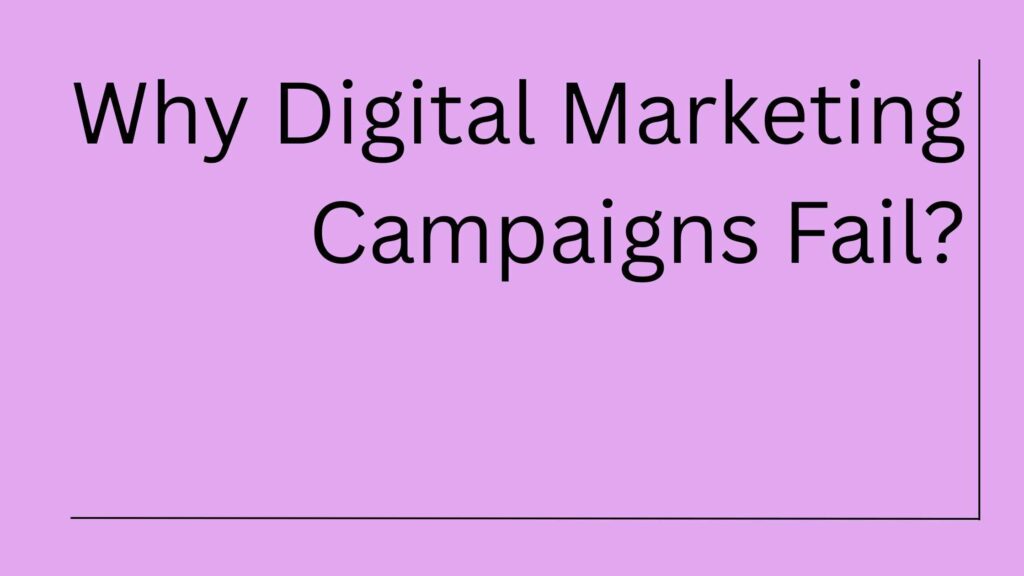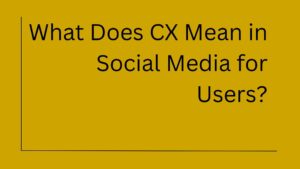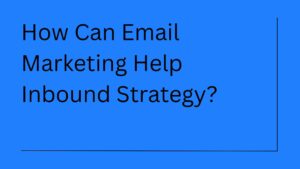You might have heard marketing professionals saying your campaigns will fail if you don’t spend enough on ads, target the wrong audience, lack proper analytics, have poor creative assets, or use outdated strategies. They all may be right; the ground reality has a lot of hidden reasons behind the screen.
Launching a digital marketing campaign is an exciting yet nerve-wracking experience. As a business owner or marketer, you’re bound to face numerous obstacles on your journey, but there’s one thing that all campaign managers fear the most: failure. And while failure is often seen as a setback, it’s also an inevitable part of the marketing learning process. According to industry research, about 70% of digital marketing campaigns fail to meet their initial objectives within the first six months.
When you look at that statistic, it’s easy to feel discouraged. However, don’t let it deter you! Knowing the common reasons behind these failures can help you avoid making the same mistakes. The fact is, many campaigns fail not because of factors beyond your control, but because of avoidable missteps. If you understand these pitfalls and learn how to navigate around them, you’ll be in a much better position to succeed.
In this article, we’ll explore the four most common reasons why digital marketing campaigns fail and provide actionable solutions to help you overcome them. By recognizing these issues early on, you’ll have the opportunity to steer your campaigns toward success.
Top 4 Reasons Digital Marketing Campaigns Fail and What to Do About It
Many campaigns fail not only due to unrealistic expectations and poorly defined objectives but also because even well-planned campaigns can face unexpected setbacks. Despite these challenges, viable solutions exist for every potential obstacle encountered.
Let’s explore deeper into the various factors contributing to the success or failure of digital marketing campaigns and discover the range of solutions available to overcome these hurdles.
1. You Fail Because You Don’t Understand Your Target Audience
One of the most critical mistakes that many marketers make is failing to truly understand who they’re trying to reach. Marketers often get caught up in the excitement of launching their campaign and forget to ask the most important question: “Does this message resonate with the people we’re trying to reach?”
Without a deep understanding of your target audience, your campaign might fail to connect with the people it’s supposed to influence. This can result in low engagement rates, poor conversion metrics, and a failure to generate meaningful ROI.
Why This Happens
Marketers are often passionate about their product or service, and this passion can sometimes blind them to the actual needs and preferences of their potential customers. Fear of negative feedback and low engagement can also lead marketers to avoid thorough audience research. Rather than investing time in understanding their market, they may choose to create content based on assumptions, thinking that their message will naturally appeal to everyone.
This approach can be damaging. If you don’t take the time to truly understand your audience’s pain points, preferences, and behaviors, you risk creating campaigns that don’t resonate with them, leaving you with messages that no one actually responds to.
Solution
To avoid this pitfall, it’s crucial to put the focus back on understanding your audience. Marketing expert Seth Godin emphasizes the importance of knowing your audience better than they know themselves. Instead of simply assuming what customers want, make audience research an integral part of your campaign development. Here are some steps you can take to ensure your campaign resonates with your target market:
- Conduct comprehensive audience research: Before you start creating content or ads, clarify who your ideal customer is and make sure you understand their behaviors and preferences. This includes analyzing demographics, psychographics, online behavior patterns, and purchasing habits.
- Create detailed buyer personas: Don’t settle for basic demographic information. Build comprehensive profiles that include pain points, goals, preferred communication channels, and decision-making processes. The more detailed your personas, the better you can tailor your messaging.
- Test and validate your assumptions: Use A/B testing, surveys, and social listening tools to validate your understanding of your audience. Continuously gather data about how your target market responds to different messages and adjust your approach accordingly.
By genuinely understanding your audience’s needs and crafting messages that speak directly to them, you’ll build stronger connections and increase your campaign’s effectiveness.
2. Campaign Might Not Go as Expected Because of a Lack of Objectives
When running a digital marketing campaign, one of the most valuable resources at your disposal is budget. However, many marketers waste money on tactics that don’t directly contribute to their business goals. If you’re not focused on the right objectives, it’s easy to get lost in the whirlwind of metrics and activities that come with digital marketing.
A lack of clear campaign objectives can lead to confusion, poor resource allocation, and ultimately disappointing results. If your efforts are spread too thin across various unrelated goals, you’ll struggle to achieve any meaningful impact.
Why This Happens
Digital marketing offers an overwhelming number of opportunities and metrics to track. From brand awareness and engagement to lead generation and sales, there’s a lot to measure and optimize. Without clear objectives or priorities, it’s easy to become distracted by vanity metrics or pursue tactics that don’t align with your business goals.
Many marketers also face the challenge of trying to accomplish too much with a single campaign, attempting to increase brand awareness, generate leads, and drive sales all at once. This can lead to diluted messaging and confused audiences who aren’t sure what action they’re supposed to take.
Solution
To avoid feeling overwhelmed and scattered in your approach, it’s essential to establish clear objectives for your campaign. Here’s how you can do that:
- Define specific, measurable goals: A clear objective can act as a compass for your campaign, guiding your decisions and tactics. Your goals should be focused and quantifiable, serving as a benchmark for measuring success throughout the campaign.
- Use the SMART framework: Apply SMART criteria (Specific, Measurable, Achievable, Relevant, Time-bound) to set clear and realistic objectives for your campaign. These goals will give you something concrete to work toward and help you stay focused.
- Prioritize your objectives: Review your goals regularly and assess whether your tactics align with your primary objectives. Eliminate activities that don’t directly contribute to your main goals, including unnecessary social media platforms, irrelevant content topics, or excessive competitor monitoring.
With a clear focus on your objectives, priorities, and success metrics, you’ll be able to channel your efforts into activities that bring you closer to your desired outcomes.
3. Your Campaigns Fail Because You Started Ignoring Data and Analytics
In the world of digital marketing, data is everywhere. However, many marketers either ignore the wealth of information available to them or don’t know how to interpret it effectively. Running campaigns without proper data analysis is like driving with your eyes closed; you might move forward, but you’re likely to crash.
Why This Happens
Some marketers find analytics intimidating or overwhelming. With so many metrics to track across multiple platforms, it’s easy to feel lost in the numbers. Others might rely too heavily on intuition or past experience, assuming they know what works without validating their assumptions with data.
Budget constraints can also play a role. Some businesses invest heavily in campaign creation and media spend but skimp on analytics tools or the expertise needed to interpret data effectively.
Solution
The truth is, data-driven decision making is crucial for campaign success. Here’s how you can start leveraging analytics effectively:
- Set up proper tracking: Before launching any campaign, ensure you have the right tracking mechanisms in place. This includes setting up Google Analytics, conversion tracking, UTM parameters, and platform-specific tracking pixels.
- Focus on actionable metrics: Don’t get overwhelmed by every available metric. Identify the key performance indicators that directly relate to your campaign objectives and focus your attention there.
- Create regular reporting schedules: Establish a routine for reviewing and analyzing your campaign data. Weekly or bi-weekly reviews allow you to spot trends, identify issues early, and make timely optimizations.
While investing in proper analytics might seem like an added expense, the insights you gain will dramatically improve your campaign performance and ROI.
4. Your Campaign Failed, Because You Prematurely Optimize It
Optimizing your campaign performance is essential, but making changes too quickly can be a recipe for disaster. Many marketers make the mistake of tweaking their campaigns too early in response to initial data or panic about early performance. While it’s tempting to make immediate adjustments, doing so without sufficient data can lead to poor decisions and missed opportunities.
Why This Happens
The desire to see immediate results can be fueled by pressure from leadership, competition concerns, or anxiety about campaign performance. Marketers might feel that they need to act fast to improve results or prove their campaign’s effectiveness. This often leads to hasty decisions, such as pausing successful ad sets too early, changing targeting parameters without proper testing, or adjusting budgets before trends become clear.
Solution
Optimization should always be done in a thoughtful, data-driven way. Rushing into changes can have counterproductive consequences. To optimize effectively, follow these guidelines:
- Allow sufficient learning periods: Before making major changes, ensure that your campaigns have run long enough to generate statistically significant data. Most platforms need at least 7-14 days to optimize delivery and provide reliable performance insights.
- Test systematically: Develop a structured testing approach that isolates variables and measures impact accurately. Consider the statistical significance of your results and avoid making decisions based on small sample sizes.
- Document and learn: Keep detailed records of what changes you make and their impact on performance. This creates a knowledge base that helps you make better optimization decisions over time.
By optimizing at the right pace and with sufficient data, you’ll ensure that your campaigns can improve performance without losing valuable momentum.
The Secret to Marketing Campaign Success: Continuous Learning
Building successful digital marketing campaigns isn’t a set-it-and-forget-it process. Sharing insights with team members, industry peers, or mentors can provide valuable perspectives and reveal new optimization opportunities. Collaboration also fosters accountability and helps distribute the workload of campaign management.
Don’t hesitate to join marketing communities, attend industry events, or work with specialists who complement your skills. The right collaborative approach can take your campaigns to new heights.
Final Thoughts
Campaign failure isn’t inevitable, but avoiding it requires awareness, planning, and a willingness to adapt. By understanding your audience deeply, setting clear objectives, leveraging data effectively, and optimizing thoughtfully, you can set your campaigns on the path to success.
Remember, every marketer faces challenges, but how you respond to them makes all the difference. Keep learning, stay data-driven, and never lose sight of your goals. Success might be closer than you think!





